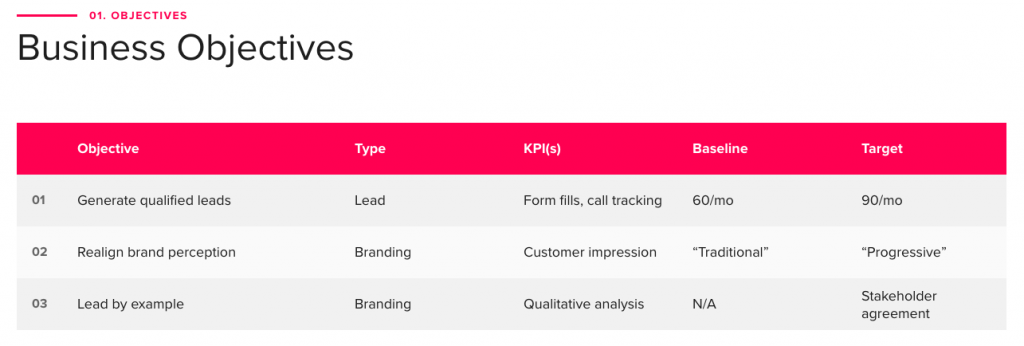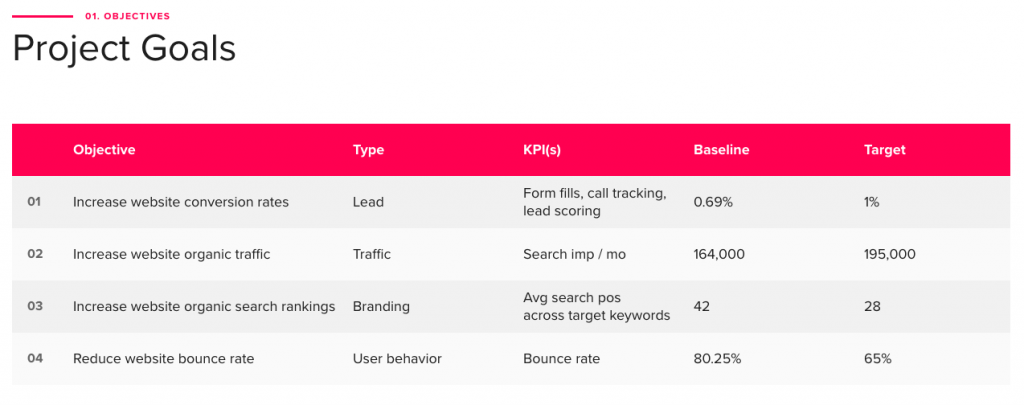- Digital and Design Strategy
- Published 01/05/2022
How To: Define Success Driving Objectives and KPIs for Inbound Marketing Campaigns
Summarize this post

Setting effective objectives is critical for inbound marketing success. Without clear, well-structured objectives, your campaign cannot be successful.
Specifically, you’ll face challenges such as:
- Lack of direction (and thus inability to arrive at your desired destination)
- Lack of clarity on what to prioritize
- Inability to create a clear strategy
- No way to determine if the project was a success
Inversely, when you have clear objectives you gain the following advantages:
- Desired outcomes are clear
- You can create a clear strategy
- Guidance for critical decisions
- Clarity around project success
Suffice to say, setting objectives is a requirement for any campaign, but defining them isn’t enough; not all objectives are well defined.
Before we go into what makes a good objective, it’s important to understand the two types of objectives– business and project.
Business vs Project Objectives
Generally speaking, you can set two types of objectives: business objectives and project objectives.
Business objectives are focused on business outcomes.
How do we hope to impact the business?
Typically business objectives are focused on either making money or saving money. E.g. increasing sales, decreasing overhead, etc.

Project objectives don’t specifically relate to a business outcome but are a driver for the project.
For example, for your website redesign, you might want a client portfolio to be used for sales calls. While this objective is related to the business objective of “increasing sales,” as one of the factors in redesigning the site it should be defined separately.

With objectives types defined, let’s discuss effective vs ineffective objectives.
Effective vs Ineffective Objectives
Poorly structured objectives can be as bad as not defining objectives. They can be unrealistic, lead the project in the wrong direction, of no real benefit to the business.
Identifying poorly defined objectives is easy, there are four common issues:
- Too vague, the desired outcome is unclear
- Irrelevant, they don’t relate to business outcomes
- Unrealistic, the objective is unobtainable
- Unquantifiable, can’t measure them
The easiest method for quality objectives is using the SMART framework. This approach is not unique to marketing or design but valuable.
SMART is an acronym and stands for:
Specific
Objectives need to be specific, clearly describing what the desired outcome is.
Measurable
Objectives need to be quantifiable. As Peter Drucker famously said, “What gets measured gets managed.” If you can’t measure success, you can’t course-correct or identify if you’re successful or not.
Achievable
Objectives need to be realistic. Is this achievable? There is no sense in setting an objective you’re unable to reach.
Relevant
Objectives need to be relevant to larger goals within the organization. Ask yourself, “why is the desired result important?”
For example, “Post every day on social media” is not a good objective. Posting on social media is an activity, it doesn’t directly relate to a larger business objective.
What are you trying to accomplish by posting on social media? The answer to this question is your actual objective. It could be increasing brand awareness, increasing sales, or better customer service.
Time-bound
Objectives need a timeframe to be successful. Without one, it’s unclear how aggressive or methodical you should be in your approach. For example, your strategy will differ for four weeks vs. four months.
Here are some good examples of SMART business objectives
- Increase website leads from organic traffic by 30% in six months
- Increase brand awareness on social media by 50% in six months
- Reduce customer support calls by 25% in eight months
With each of these examples, you can see they’re Specific, Measurable, Achievable, Relevant, and Time-bound.
With objectives defined you now need to figure out how you’ll measure success. This is accomplished by setting Key Performance Indicators (or KPIs.)
Defining Effective Key Performance Indicators (KPIs)
Key performance indicators allow you to measure overall success. But, more importantly, they will enable you to course-correct should performance lag behind your defined goals.
There are two types of KPI’s– quantitative and qualitative.
Quantitative Indicators
Quantitative metrics measure quantity, for example, leads, time on site, calls, likes, retweets, impressions, shares, etc.
Quantitative metrics are easier to define and measure, and there is no shortage of tools available to help track them. Common tools include Google Analytics, Hubspot, SproutSocial, etc.
When defining a quantitative KPI, make sure to specify what timeframe you’ll be measuring each interval, e.g., daily, weekly, monthly for clarity.
Qualitative Indicators
Some objectives can’t be quantified and need to be assessed by quality. For example, let’s say you’re refining your brand tone. You’ll be hard-pressed to find a set of metrics to measure exactly how well your new messaging and visuals align with your brand strategy.
Instead, you can survey your target audience and get their feedback. By asking them to describe how they perceive your brand you can see how well it aligns with your desired tone.
Common qualitative indicators include customer or stakeholder feedback, surveys, or exercises like the five-second test.
Establishing Baselines and Targets
Finally, each KPI needs a baseline and target; where are we at? and where do we want to end up?
For example, if your objective is “Increase leads by 30% in six months,” you need to determine how many leads you’re getting now, to know what a 30% increase would be.
Setting targets and timelines directly guide strategy. An objective with a modest increase and a long timeframe requires a different approach than an ambitious increase in a short timeframe.
Establish Objectives and Key Performance Indicators as Your First Step for Any Campaign
Setting effective objectives is the foundation of any successful inbound marketing campaign. It aligns the team on success criteria, sets guiding principles for important decisions, and allows you to measure success.
Anyone who has influence or investment in a project or campaign should be involved. Set up a steering committee and define the objectives as a group, getting buy-in and approval along the way. Make sure the objectives are frequently referenced and easily accessible so the team can be reminded of what to focus on.